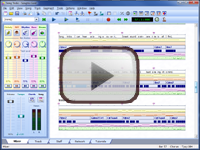(8.6) Using Major Scale Modes
So far, you may be less than impressed with the idea of scale modes. We suddenly have seven times as many scale types that we have to learn and practice! What's so good about that?
Well, it turns out that what becomes more complex in one way, makes things a lot simpler in another.
Our original problem was how to quickly find scales for improvising over different chords. To do this, we had to search for these chords in the relations tables of every scale key. Not pretty and definitely not quick.
Scale modes, on the other hand, gives us a way to short-circuit this process. Recall the basic idea of relations, that if a scale contains the notes of a chord it can be used for improvising over it.
The classic example is using the C Major scale to improvise over the Cmaj chord. The Cmaj chord is made from the degrees 1-3-5, all of which are in the C Major scale.

Likewise, we can use C♯ Major to improvise over C♯maj, or D Major to improvise over Dmaj, and so on. In general, we know that the Major scale can be used over the maj chord, as long as the root note of both are the same.
Now here's the clever bit.
There are two other modes of the Major scale - the Lydian and Mixolydian modes - which also contain the degrees 1-3-5. This means that we can also use these for improvising over maj chords.

Both of these other modes are one note different to the Major (Ionian) scale, and depending on which one you use, the feel of your melodies will be slightly different. Your growing experience will help to guide your choice in each situation.
The point is that for any maj chord we come across, we now have the simple rule of thumb of using the Major, Lydian or Mixolydian scales based on the same root note.
Playing over Cmaj? Use C Major, C Lydian or C Mixolydian. Playing over F♯maj? Use F♯ Major, F♯ Lydian or F♯ Mixolydian. The mental gymnastics of relations and transposing root notes have been completely eliminated.
With our original problem, we worked out that some scales we could use over Cmaj were C Major, F Major or G Major. Well guess what?


C Lydian is a synonym for G Major (made from the same notes) in the same way that F Lydian is a synonym for C Major (as we saw earlier). And C Mixolydian is a synonym for F Major.
In other words, using modes is something of a sleight-of-hand trick, which gives us the same results, only in much easier way.
Think of learning modes as a long term investment. By spending the time upfront in learning to play the Major scale in all of its modes, you save time forever after, whenever you need to choose an improvisation scale.
Even better, because you will be able to choose scales so quickly, it gives you the ability to improvise immediately and effectively over any chord progression that is placed in front of you.
You won't need to know the song, its scale or its key centres, you will simply be playing in the present. This makes you a very flexible and valuable band member.
Best of all, it makes your music feel ALIVE. As a musician, this is the best kick there is.
|
Topic 101 of 117
| ||
Bring these music concepts to life with the free Songtrix Bronze Edition as you create songs from chords and scales.
Then publish and share your ideas with the other musicians you meet on the ChordWizard Network.
Have questions? Join the ChordWizard Network and post them in the Music Theory forum for answers and discussions on your topics of interest.








